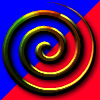To interpret the values in the angle fields ('A') on the shape editor's infobar, it is necessary to know how XX measures the angle, and which line the value refers to.
With the node as the center of an imaginary clock, always measure from zero at the three o'clock position. Counter clockwise measures positive degrees; clockwise gives negative values.
The 'A' values depend on the direction of the line. There are two 'A' fields on the shape editor's infobar -- the left hand one gives the angle of the line closer to the line's beginning (the tail), the right hand field the angle of the line closer to the line's end (the arrowhead).
If you don't know the direction of a line, you can easily judge which line a value refers to by remembering that the angle is measured beginning at a three o'clock zero point, with positive values being counter clockwise. Also, when the two lines are obviously different lengths, the different values in the Length fields ('L') will reveal which line an angle value refers to.
The attachment illustrates the values in the left and right 'A' fields. If the direction of the lines was reversed, the values in the left and right fields would simply switch. The tail symbol marks the beginning of the line, and the green dots mark three o'clock zero points.
Ed Nadie



 Reply With Quote
Reply With Quote


Bookmarks